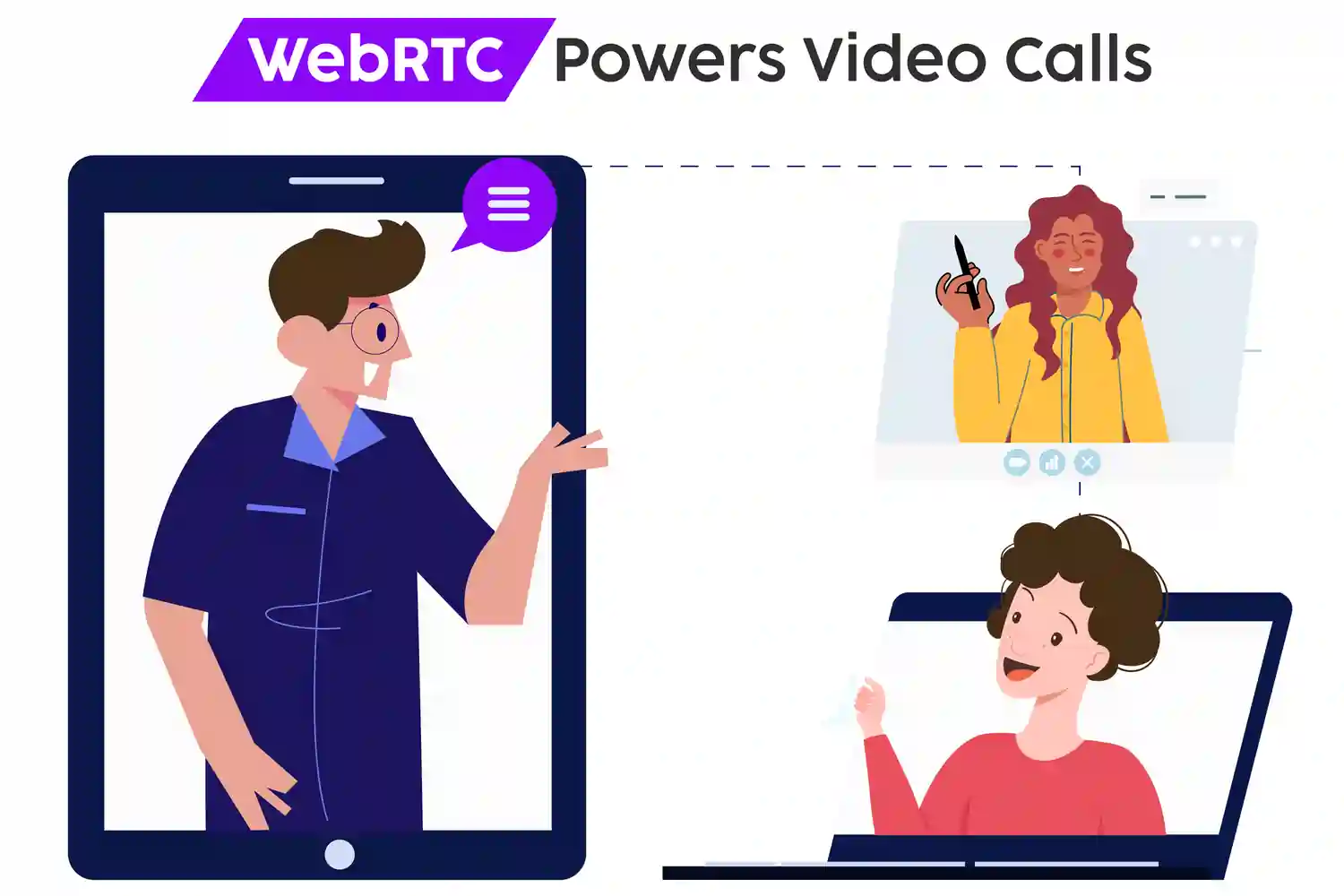WebRTC is reorganizing video calls with its real-time communication capabilities, making connections easier and more accessible. This article highlights its benefits, including low latency, enhanced security, and seamless integration into web and mobile applications.
Highlights
With Over 14 years of Experience in the IT Field, Helping Companies Optimise there Products for more Conversions

Video calls have become an essential tool in today’s fast-evolving digital world. Whether it’s bringing people together or connecting companies across the globe, video communication is now a major part of our daily lives. The rise of telemedicine and online education has driven a demand for reliable real-time communication. Telemedicine allows healthcare providers to consult with patients from different locations, while online learning platforms enable students to access educational content remotely. One technology making this possible is WebRTC (Web Real-Time Communication), an open-source framework that allows high-quality video and voice communication across different platforms.
WebRTC was developed by Google as a way to facilitate real-time communication without the need for external plugins. This technology uses peer-to-peer (P2P) connections, which means users can share audio, video, and data directly with each other. This makes WebRTC a popular choice for businesses that want to integrate real-time communication into their apps and websites.
One of the best features of WebRTC is its ability to work seamlessly across different platforms. It can be used on desktops, tablets, and smartphones, making it incredibly versatile. Whether a user is on Chrome, Firefox, or Safari, WebRTC provides a smooth and consistent video calling experience.
WebRTC works through three main components that allow it to deliver high-quality, real-time communication
Together, these components provide a complete framework that powers modern video communication, making WebRTC the backbone of many video calling applications today.
Looking to protect your customers' data? Check out Digittrix's 7 tips.
DIGITTRIX keeps your website or app secure.
One of the most significant advantages of WebRTC is its ability to work across a variety of platforms. Whether you’re using a desktop, smartphone, or tablet, WebRTC offers a reliable video calling experience. It is compatible with most web browsers, which means users can connect regardless of the device or software they are using.
This cross-platform flexibility is especially useful for companies that provide software development services. Businesses can create applications that work on multiple devices and operating systems without having to worry about compatibility issues. Whether a customer is on a Windows PC or an iPhone, WebRTC will ensure that the video call runs smoothly.
WebRTC is known for providing high-quality video and audio during calls, even in less-than-ideal network conditions. It uses advanced codecs like VP8, VP9, and Opus to reduce latency and ensure that video quality remains clear throughout the call. This is particularly important for industries like healthcare, where clear communication can make a significant difference.
The ability to deliver good video and audio quality in various conditions makes WebRTC an ideal choice for companies that rely on video calls, such as those offering telemedicine or online education services.
In today’s world, protecting user data is more important than ever. WebRTC places a strong emphasis on security by encrypting all audio and video streams using Secure Real-Time Transport Protocol (SRTP). This encryption ensures that only the intended recipients have access to the communication, making it much harder for unauthorized parties to intercept calls.
Industries like healthcare and finance, which deal with sensitive data, require secure communication methods. WebRTC’s strong focus on privacy makes it an excellent choice for businesses that prioritize the protection of user information.
WebRTC offers more than just standard video calls. It comes with additional features that enhance the user experience, such as
These features provide added value to businesses that are developing communication platforms. For example, a company creating a custom mobile app for remote collaboration can use WebRTC to build a more interactive and user-friendly solution.
Artificial Intelligence (AI) is becoming an important part of video communication, and WebRTC is well-suited to take advantage of these developments. AI can improve call quality by canceling background noise, enhancing video resolution, and even providing real-time language translation.
For example, an AI-powered WebRTC application can automatically adjust audio levels to filter out background noise, which can be especially useful in busy environments. In addition, real-time language translation can help bridge language barriers during international business meetings or customer service interactions. By integrating AI features into WebRTC applications, businesses can offer a more efficient and engaging video-calling experience.
The global rollout of 5G networks is set to revolutionize real-time communication, and WebRTC will be at the forefront of this change. With its low latency and high-speed data transmission, 5G will make video calls faster and smoother than ever before. Users will experience higher-quality video and faster connection times, which will improve communication, especially in industries like telemedicine.
For businesses that offer web development services, integrating 5G technology into their WebRTC-powered applications will give them a competitive edge. By using 5G, companies can create faster and more efficient communication solutions that meet the demands of modern customers.
The COVID-19 pandemic accelerated the adoption of telemedicine, and this trend is expected to continue in the future. Healthcare providers are increasingly relying on video communication tools to consult with patients remotely. WebRTC offers a cost-effective and easy-to-use solution for telemedicine, allowing doctors to connect with patients from anywhere.
With WebRTC, healthcare providers can conduct virtual appointments, share medical records, and offer remote consultations. The ability to provide high-quality, secure video communication makes WebRTC an ideal tool for the healthcare industry.
Thinking about telemedicine? Discover the benefits of adding a Telemedicine App to your medical practice.
Let DIGITTRIX help you elevate patient care and efficiency.
As remote work becomes more common, businesses need reliable tools for virtual collaboration. WebRTC enables teams to work together in real-time, regardless of where they are located. Companies with remote employees scattered across the globe can use WebRTC-powered platforms to hold meetings, discuss projects, and share files.
By integrating WebRTC into their communication platforms, businesses can create virtual workspaces that foster collaboration and help employees stay connected. WebRTC’s flexibility makes it a valuable tool for businesses adapting to the growing trend of remote work.
Video conferencing has become an essential part of business communication. WebRTC’s flexibility and scalability make it an ideal solution for companies looking to develop custom video conferencing platforms. Whether it’s a simple one-on-one video chat or a large group meeting, WebRTC provides the tools needed to create reliable communication solutions.
Businesses that offer website development services can use WebRTC to create video conferencing platforms tailored to their clients’ needs. By offering features like screen sharing, chat, and data exchange, WebRTC-powered platforms can improve communication and collaboration.
While WebRTC offers many benefits, it’s not without its challenges. Developers may encounter issues related to network performance, compatibility, and the need for regular updates. Maintaining a smooth user experience requires careful management of these challenges.
Quality control is essential for ensuring that WebRTC applications work well. Issues like user interface design and technical support should be addressed to create a positive experience for users. For companies offering mobile app development services, maximizing user satisfaction should be a top priority.
WebRTC has transformed the way video calls are made. Its ability to provide high-quality communication across multiple platforms, combined with strong security features, makes it an excellent choice for businesses looking to integrate real-time communication into their services. Whether you are developing mobile apps or providing web development services, WebRTC offers a flexible and cost-effective solution for video, audio, and data sharing.
As more industries adopt video communication tools, WebRTC is set to play a significant role in shaping the future of video calls. Whether it’s telemedicine, online education, or virtual collaboration, WebRTC will continue to be at the forefront of modern communication.
If you’re looking to develop a video call application, consider working with Digittrix. Our experienced developers specialize in creating custom WebRTC-powered applications that meet the needs of businesses across various industries. Reach out to us to learn more about how WebRTC can enhance your communication platforms.
In the evolving digital landscape, the demand for real-time video communication is becoming increasingly essential for smooth collaboration and user engagement. At Digittrix, we are at the forefront of this transformation, specializing in developing next-gen video call applications powered by WebRTC technology. Our solutions are designed to integrate effortlessly into your mobile or web platform, providing advanced features like instant customer support, real-time team collaboration, and enriched user experiences.
WebRTC is revolutionizing video communication by offering high-quality, secure connections without the need for additional plugins or software. Whether your business requires a robust video communication tool for internal teams or direct customer interactions, our expert developers are equipped to create a custom WebRTC solution that meets your unique needs. With 14 years of industry experience, Digittrix is committed to making sure your application leverages the latest advancements in video technology, keeping you ahead in a competitive market.
If you're interested in harnessing the future of video calls with WebRTC and want to know how to get started, schedule a consultation with our expert technical managers by calling +91 8727000867
or emailing us at digittrix@gmail.com for any inquiries.

Do you need help in Mobile App development?




Join over 1500+ businesses we've already helped!
Yes, WebRTC is widely used in telemedicine applications, enabling healthcare providers to conduct secure and high-quality video consultations with patients. Its robust security features and ability to maintain video quality make it ideal for telehealth solutions.
AI can improve WebRTC by offering features such as noise cancellation, virtual backgrounds, and real-time language translation. These enhancements create a better user experience during video calls and improve communication effectiveness.
The rollout of 5G technology will significantly increase the performance of WebRTC-powered applications. With ultra-low latency and high-speed data transfer, users will experience faster connections and improved video quality, making real-time communication even more seamless.

©2025Digittrix Infotech Private Limited , All rights reserved.